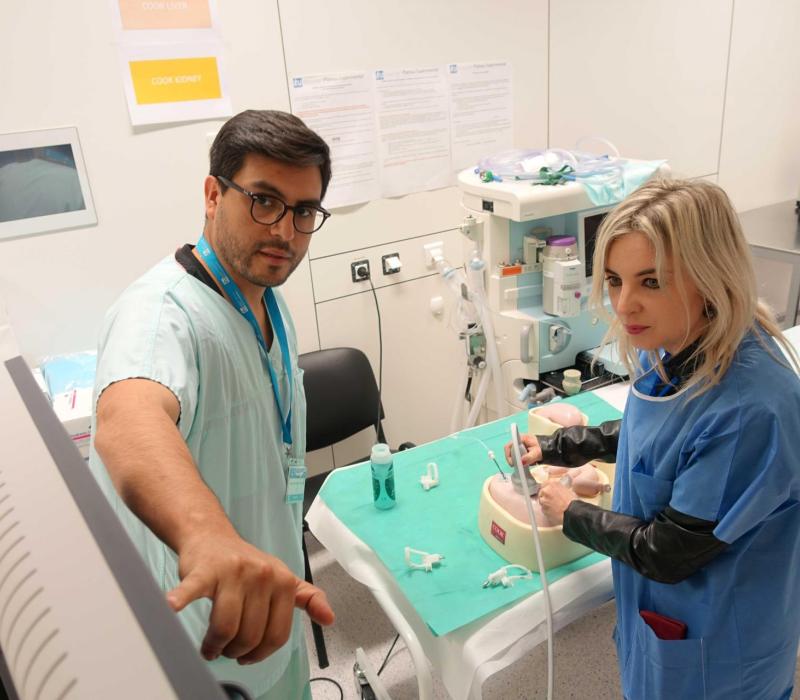SPECIFICATIONS FOR INDIVIDUAL EXAMINATIONS
Introduction
Presentation
In this module we will present the echographic analysis of normal organs or abdominal structures and their main pathologies. For each organ or structure we will evaluate the patient preparation, the imaging technique and the normal sonoanatomy
 17
lessons
17
lessons
 3
speakers
3
speakers
 06:17
hours
06:17
hours
 64
followers
64
followers
Course directors

Paul Magotteaux
Radiology
IHU-Strasbourg

Objectives
We will present how to interpret the most frequent pathologies for each organ.
Lessons
Liver and gallbladder: normal US aspects
The next four lectures will focus on the ultrasound examination of the gallbladder and liver.
Gallblader and biliary tract diseases : Main sonographic aspects
This lecture focuses on the gallbladder and biliary tract diseases.
Hepatic segmentation and sonography
This lecture is first a reminder of liver segmentation and the anatomical relationships between liver vessels and segments.
Based on the spatial arrangement of the liver, liver segments are identified by ultrasound, the markers are specified and the main points of reference are noted.
Liver pathology: Main ultrasound aspects
This lecture is a review of the ultrasound changes observed in cases of diffuse chronic liver disease or in focal pathology.
Bladder Ultrasonography
The aim of this short lecture is to provide essential knowledge for the technical aspect with essential knowledge of the different orientations needed in order to obtain a more complete examination of the organ.
Kidney Ultrasonography
The aim of this short lecture is to provide essential knowledge for the technical aspect with essential knowledge of the different orientations needed in order to obtain a more complete examination of the organ.
The fundamentals of pancreas echography
Pancreatic ultrasound can be an efficient and valuable tool in many common diseases such as pancreatitis and pancreatic neoplasms.
Performing pancreatic ultrasound is difficult and interpreting the images is not an easy task.
Pancreas pathology: Pancreatitis
Knowledge of ultrasound findings in common pancreatic diseases and particularly in pancreatitis is crucial to obtain good imaging and clinical outcomes.
There are three main kinds of pancreatitis: acute, chronic and focal pancreatitis. Each of them have specific ultrasound signs.
Pancreatic Tumors
Most patients with newly diagnosed pancreatic cancer have disease that is considered locally advanced and unresectable at the initial diagnosis. Ultrasound is the common first line imaging for the evaluation of patients with a suspected pancreatic tumor.
Spleen - Part 1
The ultrasound scan is a widely available non-invasive and useful means of diagnosing splenic diseases.
Because splenic abnormalities are relatively rare, the clinician is unlikely to be as familiar with them as with those of the liver.
Spleen - Part 2
The ultrasound scan is a widely available non-invasive and useful means of diagnosing splenic diseases.
Because splenic abnormalities are relatively rare, the clinician is unlikely to be as familiar with them as with those of the liver.
Aorta
Abdominal aortic aneurysm is a common cause of death in elderly patients. The best predictor of rupture is maximal aneurysm diameter: as it increases, the risk of rupture increases. Aneurysms over 5 cm in diameter have a high risk of rupture.
Bowel diseases
Abdominal aortic aneurysm is a common cause of death in elderly patients. The best predictor of rupture is maximal aneurysm diameter: as it increases, the risk of rupture increases. Aneurysms over 5 cm in diameter have a high risk of rupture.
Abdominal wall
Echography has advantages over other imaging modalities: the ability to examine patients in both upright and supine positions, to use dynamic maneuvers such as Valsalva and compression and to to document motion in real time.
Post-operative complications
Extremely compact ultrasound devices can be used in virtually any environment where medical care can be delivered. Such equipment is easily deployed in emergency settings as it can be used very quickly at the bedside.
Doppler imaging - Part 1
Doppler ultrasound examination is an imaging technique that combines anatomical information with blood flow velocity derived using Doppler principles to generate a Doppler spectrum and color-Doppler coded mapping of tissue velocities superimposed on grey-scale images of tissue anatomy.
Doppler imaging - Part 2
Doppler ultrasound examination is an imaging technique that combines anatomical information with blood flow velocity derived using Doppler principles to generate a Doppler spectrum and color-Doppler coded mapping of tissue velocities superimposed on grey-scale images of tissue anatomy.
